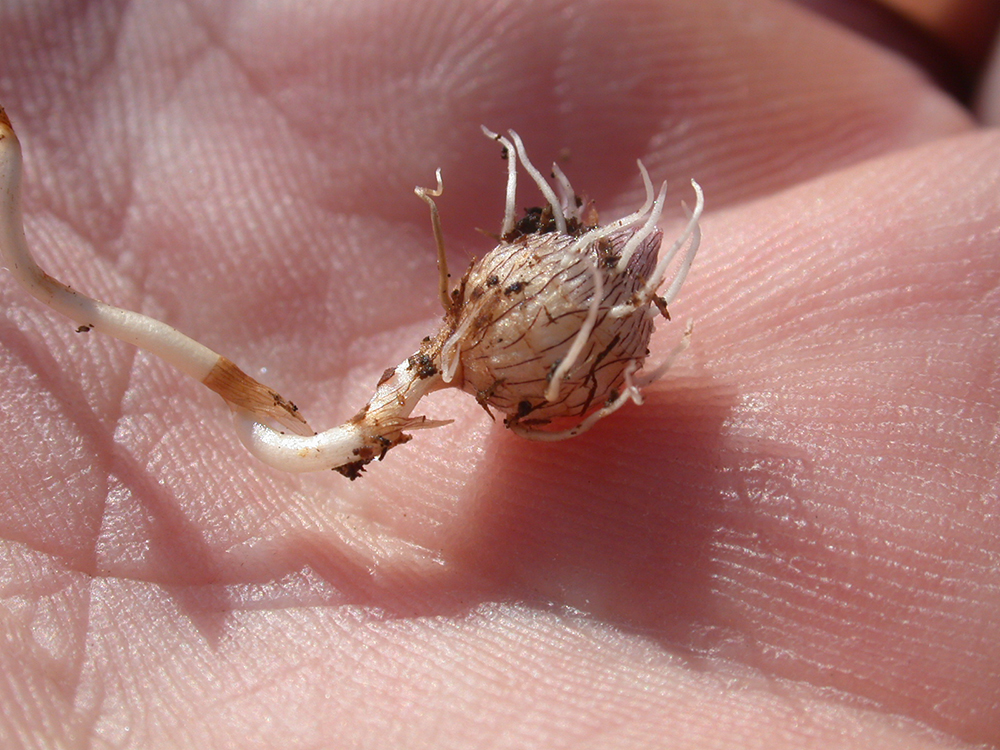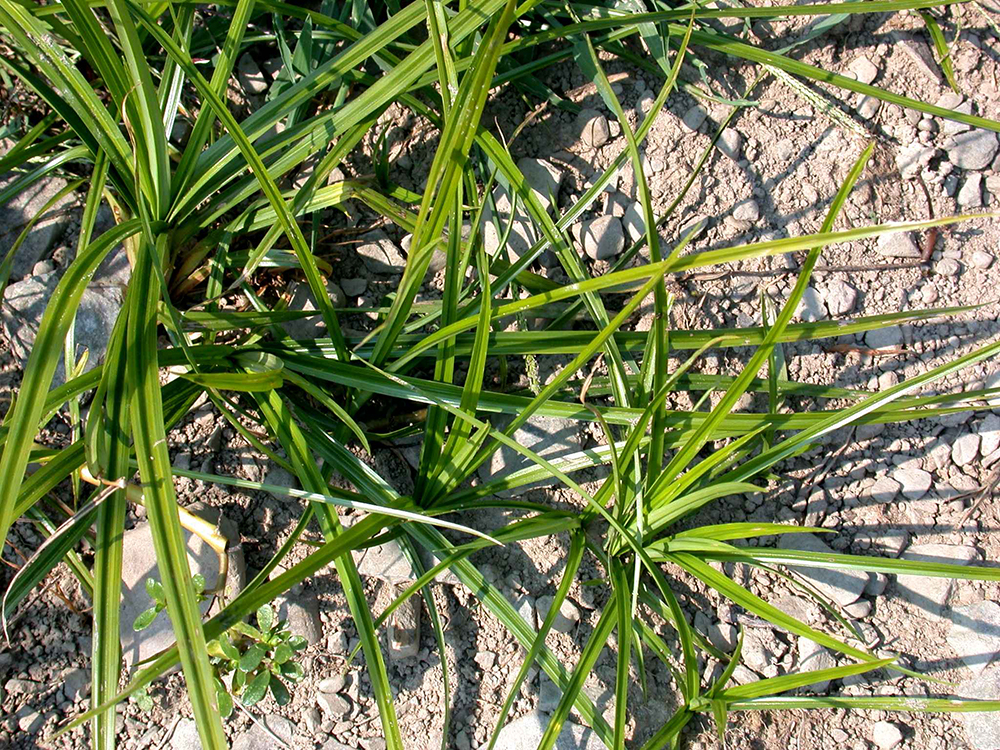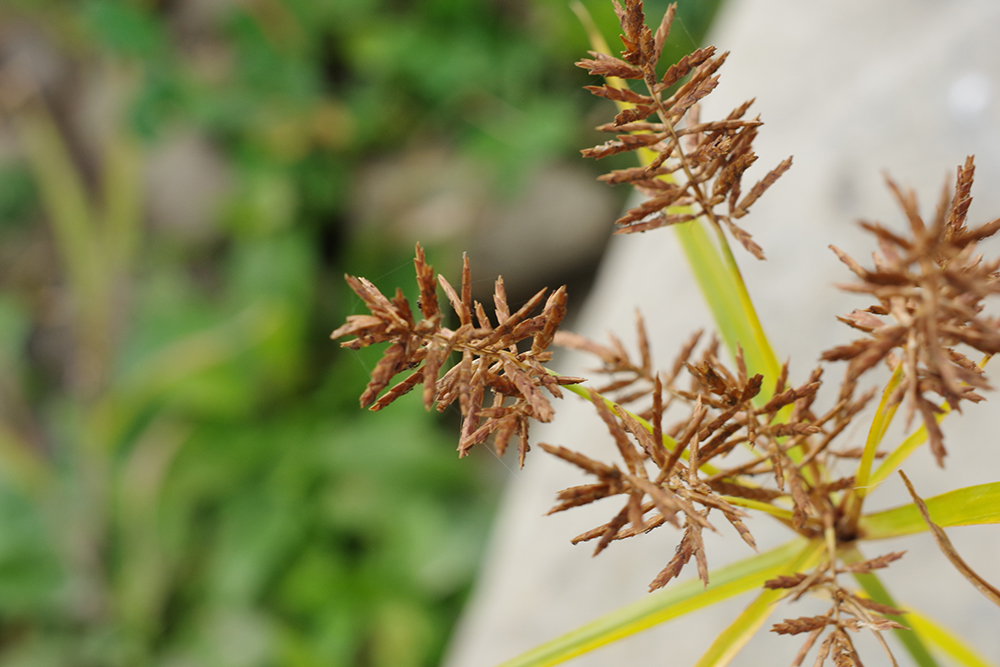Other common names: chufa, rush nut, yellow nut grass, northern nutgrass, coco, coco sedge, edible galingale



Cyperus esculentus L.
Identification of Yellow Nutsedge
Family: Sedge family, Cyperaceae
Habit: Grass-like perennial, spreading by rhizomes and tubers
Description: Seedlings have very similar aboveground characteristics to the more commonly occurring vegetative shoots. Newly emerging vegetative shoots have three glossy, light green, grass-like leaves. Leaves are flat or slightly V shaped and set around a very short stem in threes such that the shoot base is triangle shaped. Foliage of the mature plant is similar to the young plant with leaves 8–36 inches long by 0.2–0.4 inch wide. Leaves are long, tapered and sharply pointed with a prominent midrib and parallel veins that sometimes give the leaves a ridged appearance. Leaves lack ligules and auricles and have a closed, overlapping sheath that forms a triangular, three-edged, unbranched, stem-like structure at the base. The inflorescence develops at the end of a 0.5–3 foot-long triangular, spongy or corky centered, yellow-green stem that is usually no longer than the leaves. Several long, lanceolate, green, roughly horizontal, leaf-like bracts are located just below the inflorescence; they are of equal or lesser length than the inflorescence. The inflorescence consists of multiple stalked, yellowish, bottlebrush-shaped clusters of spikelets. Flowers are arranged into groups of three-sided, 0.1 inch-long, oval shaped, yellow-brown spikelets. The dry fruit contains one light brown seed. Seeds often fail to germinate; instead, extensive underground networks of rhizomes and tubers perpetuate yellow nutsedge. Scaly white rhizomes, reaching up to 6.5 feet in all directions, give rise to new tubers at their tips. The tubers are white and scaly when young. Mature tubers are hard, round, nutlike, brown to black in color, and 0.13–0.75 inch in diameter; they eventually shed their scales, enlarge into bulbs and give rise to vegetative shoots and roots.
Similar species: Purple nutsedge (Cyperus rotundus L.) has dark green foliage and purple inflorescences. Purple nutsedge foliage tends to be shorter than yellow nutsedge foliage, with tips blunt compared to the acutely elongated tips of yellow nutsedge. Purple nutsedge tubers are produced along the length of the rhizome, not just at the tips.
Management of Yellow Nutsedge
Although some yellow nutsedge tubers may form as deeply as 18 inches, the vast majority of tubers are found in the top 6 inches of soil. Consequently, this species is sensitive to tillage in late spring and early summer after the tubers have sprouted but before daughter plants or new tubers have formed. Although the tubers can make new sprouts from dormant buds, these will be weaker and more easily controlled by cultivation. Thus, crop rotations that include late spring/early summer tillage help control yellow nutsedge populations. By the same principle, in early-planted row crops, deep cultivation once or twice beginning in early June will substantially reduce a yellow nutsedge population, and in a competitive crop it may provide sufficient control for the remainder of the season. Tillage after harvest of summer harvested crops will help disrupt tuber formation, which occurs primarily in late summer and fall.
The tubers will die if you can dry them out completely. You can do this most effectively by repeatedly turning the soil during dry weather. Solarization can be an effective control measure in climates where soil can be heated in excess of 113°F. However, soil temperatures may not always achieve these levels for sufficient duration throughout the soil profile from which tubers emerge. An integrated approach where fallow tillage precedes solarization can achieve more reliable results.
Since the plants are short (less than 18 inches), a dense planting or other measures that increase the competitiveness of the crop are particularly effective for suppressing yellow nutsedge. Similarly, rotations that include highly competitive crops will help manage yellow nutsedge populations. Although potatoes are relatively competitive, avoid planting them in infested fields because nutsedge rhizomes can penetrate potato tubers and make them unmarketable. Good fertility is more likely to increase the vigor of the crop than the growth of yellow nutsedge.
The large food storage in the tubers allows yellow nutsedge to penetrate even very thick layers of organic mulch materials (e.g., thicker than 6 inches). Allelopathic substances from sweet potatoes, wild radish and rye, however, reduce yellow nutsedge density and vigor. Suppression of yellow nutsedge by rye is most effective if the rye root system is present as well as the straw. The sharp points of the newly emerged shoots easily pierce thin, opaque horticultural plastic film but not clear plastic film, where light induces leaf expansion and blunts the sharpness of the emerging shoot. Thicker plastic mulch, whether opaque or clear, can suppress yellow nutsedge, as can heavier materials such as landscape fabric. Tuber production and patch expansion also are suppressed by plastic film.
One of the most effective methods for managing yellow nutsedge is to occasionally graze swine on the field. Their eradication of tubers will be quicker and more complete if the soil is tilled first. A novel approach using a peanut digger in conjunction with a collection cart has successfully removed substantial numbers of tubers from fields in the southeastern United States. Alternatively, a peanut digger can be used to bring the tubers to the soil surface to dry them out.
Ecology of Yellow Nutsedge
Origin and distribution: Yellow nutsedge is native to North and South America, southern Europe and Africa. Native populations in North America occur in wetlands, and weedy races in the United States may be introduced. The species occurs widely in the United States and southern Canada with the exception of the Intermountain West and the prairie provinces of Canada.
Seed and tuber weight: Mean seed weights vary from 0.13–0.31 mg. Mean tuber weight varies substantially between locations, ranging from 70–75 mg in Minnesota and Illinois, to 150–160 mg in both Georgia and another site in Illinois, to 700 mg in Maryland.
Dormancy and germination: The tubers are dormant when produced and usually sprout the following spring. Water-soluble chemicals in the skin of the tubers apparently enforce dormancy because washing breaks dormancy. Water percolating through the soil probably acts similarly. Tuber dormancy, however, is also broken by one month of cold treatment (38–50°F). Thus, tubers usually do not sprout until they have overwintered. Temperatures above 54°F are required to initiate tuber sprouting. Cold treatment also reduces the dormancy of seeds. Some seeds will germinate in the dark provided the temperature is higher than 75°F, but germination in light is greater than in dark. In light at 95°F, nearly all seeds will germinate. Nitrate has minimal effect on seed germination. Germination increases with increasing seed mass.
Tuber and seed longevity: Tubers can persist in the soil for three years, but few survive more than two winters in most field situations. Half-life was 4.4–5.8 months. Most seeds near the soil surface germinate or die within three years, but deeply buried seeds last longer. Germination of seeds stored in cold moist conditions was less than for seeds stored in cold dry conditions.
Season of emergence: Dormant tubers sprout in mid-spring and form a non-dormant basal bulb near the soil surface, from which the shoot emerges from late spring to early summer. Later-emerging shoots arise primarily from upturned rhizomes. These thicken to form additional basal bulbs and aboveground shoots. Such shoots will continue to form throughout the growing season. Seed germination is in the spring, but seedlings are extremely rare.
Emergence depth: Percentage emergence is greatest when tubers are in the top 4–8 inches of soil, but emergence from up to 32 inches has been recorded. Seedlings emerge best from seeds very near the soil surface. A few seedlings can emerge from up to 1 inch but none from 1.5 inch. Successful emergence and establishment require long periods of wet soil, so seedling establishment in agricultural fields is rare.
Photosynthetic pathway: C4
Sensitivity to frost: The foliage is sensitive to frost. Only the tubers overwinter, and even these survive poorly at soil temperatures below 20°F. Tubers at shallow depths of 1–2 inches are most susceptible to winterkilling.
Drought tolerance: Yellow nutsedge can tolerate a few weeks of drought, but growth and tuber production are enhanced by soil moisture conditions optimum for crops.
Mycorrhiza: Yellow nutsedge is readily colonized by mycorrhizae.
Response to fertility: This species is relatively unresponsive to soil fertility.
Soil physical requirements: Yellow nutsedge tolerates a wide range of soil texture and drainage conditions, including sustained flooding, but it does poorly on sandy soils unless the field is irrigated regularly.
Response to shade: This species tolerates shade poorly but can still produce some tubers at low light levels.
Sensitivity to disturbance: Yellow nutsedge plants are most sensitive to disturbance after several leaves have formed. At this point, the original tuber and the newly formed basal bulbs are both low on stored carbohydrates, and any new shoots that sprout will be weak. After that, tubers may be spread around the field by tillage and cultivation implements.
Time from emergence to reproduction: Most reproduction occurs by formation of tubers, and these can begin forming within three weeks of shoot emergence from the previous tuber. Typically, however, long days promote basal bulb formation and vegetative growth, while tuber formation occurs as day length shortens in the fall. Tuber formation of plants that emerged in spring begins in late summer at a day length of 14 hours, but it is delayed by a month or more if emergence did not occur until summer. Flowering occurs from July to September when day length is 12–14 hours. Time from emergence to flowering for plants grown from tubers in Wisconsin was eight weeks. When plants were grown from seeds in New England, flowering occurred in late August and September, approximately 13–16 weeks after emergence. Viable seeds are produced beginning two to three weeks after flowers open.
Pollination: Yellow nutsedge is wind pollinated and is self-sterile.
Reproduction: Most reproduction is vegetative and occurs via both production of tubers and production of new shoots from rhizomes. By the end of the season more than one-third of the total plant dry weight is composed of tubers. A single tuber planted in Minnesota and allowed to grow without competition or management produced 6,900 tubers by the fall and 1,900 daughter plants the following spring in a 34-square-foot patch. A single tuber in eastern Oregon produced 20,000 tubers. No seeds are produced by about 90% of populations because they are composed of a single clone. One seed producing population averaged 1,500 viable seeds per inflorescence. Only 1–17% of flowers contain seeds.
Dispersal: Since seedlings are very rare, dispersal is primarily by transport of the tubers. The low genetic diversity among yellow nutsedge populations is consistent with asexual dispersal by tubers. In natural conditions, transport is by water. Populations probably occasionally establish in low lying fields when flood waters wash in tubers. Most populations in agricultural fields probably establish from tubers brought in on tillage and cultivating machinery. Sources of new populations include root balls of nursery stock and topsoil that is spread after construction. If uprooted nutsedge plants are composted at low temperatures, the resulting compost can potentially spread the weed.
Common natural enemies: Few natural enemies have been reported for this species, and our observations in central New York indicate negligible damage by natural enemies in the field.
Palatability: The foliage is unpalatable. The tubers or “tiger nuts” are highly palatable and have been a foodstuff in Mediterranean countries for centuries. Tiger nuts have higher oil, protein and starch content than most tuber crops, and a milky beverage product of tiger nuts called “horchata de chufa” is considered a health drink. The domestic “chufa” is a variety of yellow nutsedge and is commonly planted to attract wildlife for sport. Swine are fond of the tubers.
Note: Yellow nutsedge tubers and tuber extracts are allelopathic to crops.
Summary Table of Yellow Nutsedge Characteristics
| Yellow Nutsedge | ||||||||
|---|---|---|---|---|---|---|---|---|
| Growth habit | Perennial overwinter organ | Emergence period from perennial organs | Optimum emergence depth (inches) from perennial organs | Time/stage of lowest reserves | Photosynthesis Type | Frost tolerance | Drought tolerance | Mycorrhiza |
| short sedge | tubers | late spring to early summer | 4–8 | late summer, flowering | C4 | low | high | yes |
| Fertility Response | Importance of seeds to weediness | Seed weight (mg) | Dormancy of shed seeds | Factors breaking dormancy | Optimum temperarature range (F) for seed germination | Seedling emergence period | Emergence to flowering (weeks) | |
| low | low | 0.13–0.31 | yes | li | 95 | spring | 8–12 | |
Table Key
Drought tolerance: Relative tolerance of aboveground plants to drought (high, moderate, low).
Emergence period from perennial organs: Time of year when most emergence occurs from perennial overwintering organs in the typical regions of occurrence for each weed. Some emergence may occur outside of this range.
Emergence to flowering: Length of time (weeks) after emergence from perennial organs to the beginning of flowering in the typical regions of occurrence. Note that this refers to established perennial plants, recognizing that some species may not flower in their initial year of establishment.
Factors breaking dormancy: The principle factors that are reported to break dormancy and facilitate germination. The order of listing does not imply order of importance. Abbreviations are:
- scd = seed coat deterioration
- cms = a period subjected to cold, moist conditions
- wst = warm soil temperature
- li = light
- at = alternating day-night temperatures
- ni = nitrates
Flowering to viable seed: Length of time (weeks) after flowering for seeds to become viable.
Frost tolerance: Relative tolerance of aboveground shoots to freezing temperatures (high, moderate, low).
General: The designation "-" signifies that data is not available or the category is not applicable.
Growth habit: A two-word description. The first word indicates relative height (tall, medium, short, prostrate) and the second word indicates degree of branching (erect, branching, vining).
Importance of seeds to weediness: The relative importance of seeds to dispersal, genetic diversity and survival of the species as a weed in agricultural environments (high, moderate, low).
Mycorrhiza: Presence of mycorrhizal fungi. “Yes” if present; “no” if documented not to be present, “unclear” if there are reports of both presence and absence; “variable” if the weed can function either with or without, depending on the soil environment.
Optimum emergence depth from perennial organs: Soil depths (in inches below the soil surface) from which most shoots emerge from perennial organs. Lower rates of emergence usually will occur at depths above or below this range.
Optimum temperature range for germination: Temperature (Fahrenheit) range that provides for optimum germination of non-dormant seeds. Germination at lower percentages can occur outside of this range. The dash refers to temperature range, and the slash refers to alternating day/night temperature amplitudes.
Perennial overwinter organ: Principal plant organ that survives winter and from which growth resumes in subsequent years.
Photosynthesis type: Codes “C3” or “C4” refer to the metabolic pathway for fixing carbon dioxide during photosynthesis. Generally, C3 plants function better in cooler seasons or environments and C4 plants function better in warmer seasons or environments.
Pollination: “Self” refers to species that exclusively self-pollinate; “cross” refers to species that exclusively cross-pollinate; “self, can cross” refer to species that primarily self-pollinate, but also cross-pollinate at a low rate; and “both” refers to species that both self-pollinate and cross pollinate at relatively similar rates.
Response to nutrients: Relative plant growth response to the nutrient content of soil, primarily N, P, K (high, moderate, low).
Seed dormancy at shedding: “Yes” if most seeds are dormant when shed; “Variable” if dormancy is highly variable; “No” if most seeds are not dormant.
Seed mortality in tilled soil: Range of mortality estimates (percentage of seed mortality in one year) for seeds in tilled soil. Values were chosen for seeds placed within the tillage depth and subjected to at least annual tillage events. Seed losses are the result of dormancy-breaking cues induced by tillage, germination and deterioration of un-germinated seeds.
Seed mortality in untilled soil: Range of mortality estimates (percentage of seed mortality in one year) for buried seeds in untilled soil. Values were chosen where possible for seeds placed at depths below the emergence depth for the species and left undisturbed until assessment. Mortality primarily represents seed deterioration in soil.
Seed weight: Range of reported values in units of “mg per seed."
Time/stage of lowest reserves: Time of year and/or weed growth stage at which carbohydrate reserves are lowest. This usually corresponds to the time when the weed is most susceptible to weed management operations.
Typical and high seed production potential: The first value is seed production (seeds per plant) under typical conditions with crop and weed competition. The second value, high seed production, refers to conditions of low density without crop competition. Numbers are rounded off to a magnitude that is representative of often highly variable reported values.
Typical emergence season: Time of year when most emergence occurs in the typical regions of occurrence for each weed. Some emergence may occur outside of this range.
Weed: Weed common name as listed in the Weed Science Society of America Composite List of Weeds, presented in alphabetical order.
Further Reading
Johnson, W.C. III, R.F. Davis and B.G. Mullinix Jr. 2007. An integrated system of summer solarization and fallow tillage for Cyperus esculentus and nematode management in the southeastern coastal plain. Crop Protection 26: 1660–1666.
Johnson, W.C. III, T.R. Way and D.G. Beale. 2015. An undergraduate student project to improve mechanical control of perennial nutsedges with a peanut digger in organic crop production. Weed Technology 29: 861–867.
Mulligan, G.A. and B.E. Junkins. 1976. The biology of Canadian weeds. 17. Cyperus esculentus L. Canadian Journal of Plant Science 56: 339–350.
Stoller, E.W. 1981. Yellow Nutsedge: A Menace in the Corn Belt. U.S. Department of Agriculture Technical Bulletin No. 1642. 16 p.
Stoller, E.W. and L.M. Wax. 1973. Yellow nutsedge shoot emergence and tuber longevity. Weed Science 21: 76–81.

